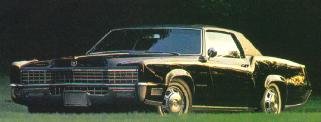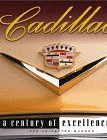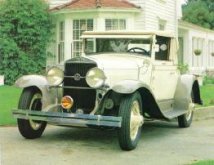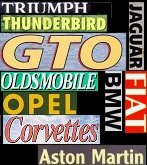
As it happened, Cadillac began experimenting with front drive during
the Brougham years. But though a running chassis tested in late 1959
looked promising, fwd was still a relative novelty and by no means proven.
Thus, when General Motors stylists began sketching a "new Brougham"
that October, they devised shapes adaptable to either front or rear drive.
 They worked on this experimental project, coded XP-727, through
early 1962, when GM management approved front drive for a new
"personal" Cadillac. The clincher was the successful engineering effort
toward what would be GM's first production front-driver, the 1966
Oldsmobile Toronado. Engineering for both models was more or less
combined by summer 1963, in project XP-784, but Eldorado styling
originated in two separate programs: XP-820, begun in September, and the
evolutionary XP-825, begun in December. The latter was production --
approved in May 1964, with shorter overhangs the major subsequent
change. Unlike previous Eldorados, only a coupe was planned, with no
evident thought of a convertible.
They worked on this experimental project, coded XP-727, through
early 1962, when GM management approved front drive for a new
"personal" Cadillac. The clincher was the successful engineering effort
toward what would be GM's first production front-driver, the 1966
Oldsmobile Toronado. Engineering for both models was more or less
combined by summer 1963, in project XP-784, but Eldorado styling
originated in two separate programs: XP-820, begun in September, and the
evolutionary XP-825, begun in December. The latter was production --
approved in May 1964, with shorter overhangs the major subsequent
change. Unlike previous Eldorados, only a coupe was planned, with no
evident thought of a convertible.
 The new-generation Eldorado naturally inherited the Toronado's novel
"split" driveline. This comprised a three-speed Turbo Hydra-Matic
transmission mounted longitudinally beside the engine and driven from the
flywheel by a Morse "Hy-Vo" inverted-tooth chain. Basic suspension was
also shared: front A-arms, longitudinal torsion bars, and anti-roll bar; at the
rear, a drop-center beam axle on single-leaf springs and four shock
absorbers, two vertical, two horizontal.
The new-generation Eldorado naturally inherited the Toronado's novel
"split" driveline. This comprised a three-speed Turbo Hydra-Matic
transmission mounted longitudinally beside the engine and driven from the
flywheel by a Morse "Hy-Vo" inverted-tooth chain. Basic suspension was
also shared: front A-arms, longitudinal torsion bars, and anti-roll bar; at the
rear, a drop-center beam axle on single-leaf springs and four shock
absorbers, two vertical, two horizontal.
 Beyond this were major differences. There was styling, of course: distinctly
Cadillac, beautifully masterminded by GM design chief William L. Mitchell --
and so different from both the Toro and the second-generation 1966 Buick
Riviera that some observers wondered whether they all really used the same new
GM E-body. An Eldorado could have only Cadillac power, so the division's 429
V-8, new for '64, was modified for front drive with a new oil pan, exhaust
manifolds, accessory drive, and engine mounts. Output was the same as for
other '67 Cadillacs: 340 horsepower and 480 pounds/feet torque with
four-barrel carburetor and a 10.5:1 compression ratio. Steering was GM's usual
recirculating-ball mechanism, with variable-ratio power assistance. Standard
front brakes were drums, but the optional power assisted four-piston radially
vented front discs were a low-cost option ($105). At the back were duo-servo
11-inch diameter drums. (The Toro started with drums, then switched to front
discs for '67.)
Beyond this were major differences. There was styling, of course: distinctly
Cadillac, beautifully masterminded by GM design chief William L. Mitchell --
and so different from both the Toro and the second-generation 1966 Buick
Riviera that some observers wondered whether they all really used the same new
GM E-body. An Eldorado could have only Cadillac power, so the division's 429
V-8, new for '64, was modified for front drive with a new oil pan, exhaust
manifolds, accessory drive, and engine mounts. Output was the same as for
other '67 Cadillacs: 340 horsepower and 480 pounds/feet torque with
four-barrel carburetor and a 10.5:1 compression ratio. Steering was GM's usual
recirculating-ball mechanism, with variable-ratio power assistance. Standard
front brakes were drums, but the optional power assisted four-piston radially
vented front discs were a low-cost option ($105). At the back were duo-servo
11-inch diameter drums. (The Toro started with drums, then switched to front
discs for '67.)
 The Eldorado also differed in its inch-longer
wheelbase -- 120 in all --
and unique suspension tuning. The latter included standard rear leveling
and narrower, softer-riding tires, though the Cadillac handled at least as
well as the Olds. Indeed, the '67 Eldorado was the closest thing to a
"driver's Cadillac" in years. Motor Trend found it could power
through comers in utter safety. "The front tires will make a lot of noise,
but the car will stick." It could also go: 0-60 mph in about 10 seconds,
0-80 in 15.3, 125-130 mph flat out. All this, plus "the traditional silence,
comfort and luxury that buyers of this nameplate expect," as MT
observed.
The Eldorado also differed in its inch-longer
wheelbase -- 120 in all --
and unique suspension tuning. The latter included standard rear leveling
and narrower, softer-riding tires, though the Cadillac handled at least as
well as the Olds. Indeed, the '67 Eldorado was the closest thing to a
"driver's Cadillac" in years. Motor Trend found it could power
through comers in utter safety. "The front tires will make a lot of noise,
but the car will stick." It could also go: 0-60 mph in about 10 seconds,
0-80 in 15.3, 125-130 mph flat out. All this, plus "the traditional silence,
comfort and luxury that buyers of this nameplate expect," as MT
observed.
 That was more than enough to make the first front-drive Cadillac a
first-year sellout. True, production was deliberately limited to about 10
percent of total division volume -- though it ended up slightly short of that
at 17,930 -- but this was only to ensure exclusivity as well as high quality.
Abetting the latter was a special new one-shift Eldorado assembly line at
Cadillac's Clark Avenue home plant in central Detroit, one reason the
Eldorado bowed a year behind Toronado. Other reasons included Cadillac's
desire to improve on Oldsmobile's work -- and that the Eldo have its own
moment in "the white light of publicity."
That was more than enough to make the first front-drive Cadillac a
first-year sellout. True, production was deliberately limited to about 10
percent of total division volume -- though it ended up slightly short of that
at 17,930 -- but this was only to ensure exclusivity as well as high quality.
Abetting the latter was a special new one-shift Eldorado assembly line at
Cadillac's Clark Avenue home plant in central Detroit, one reason the
Eldorado bowed a year behind Toronado. Other reasons included Cadillac's
desire to improve on Oldsmobile's work -- and that the Eldo have its own
moment in "the white light of publicity."
Publicity it earned, from reporters who suddenly seemed to forget all
about the year-old Toronado. Maybe they were dazzled by the elegant
lines, the wreath-and-crest heraldry, or the $6277 base price (about $1500
upstream of that year's Toro). Whatever the cause, the newest member of
the upper-crust Fleetwood family was almost universally praised.
Automobile Quarterly gave the Eldorado its 1967 "Design and
Engineering Excellence" award. Car Life declared it "beyond the
scope of today's luxury/specialty concept ... the sort of visually distinctive,
tastefully luxurious, enormously expensive, individualistic conveyance
which characterized the Classic Era of automobile design." Cadillac simply
called its new Eldorado the "World's finest personal car," while touting its
"Elegance in Action."
| FLEETWOOD ELDORADO SUB-SERIES 693 |
|---|
| Model Number | Style Number | Body Type | Seating | Factory Price | Shipping Weight | Production Total |
|---|---|---|---|---|---|---|
| 67-393 | 69347-H | 2-door Hardtop
Coupe | 6 | 6277 | 4590 | 17,930 |
| ENGINE |
|---|
| CHASSIS |
|---|
| POWER TRAIN OPTIONS |
|---|
| CONVENIENCE OPTIONS |
|---|
| HISTORICAL |
|---|

Books about Cadillac |

History of LaSalle |

Books on other automobiles |
|---|
1964 |
1965 |
1966 |
1968 |
1969 |
1970 |
|---|
